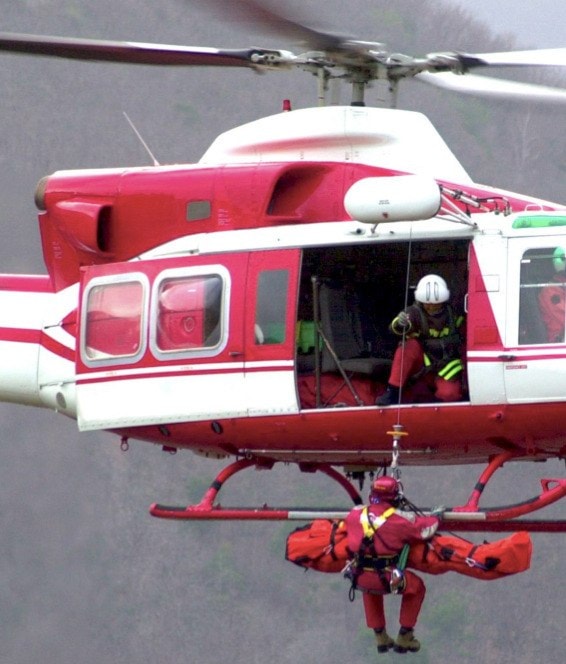Prompted by a logger injury on Haida Gwaii, a new report says B.C. needs air ambulance services similar to those in Alaska or Washington State.
Both states guarantee that people in medical emergencies can be taken to a Level 3 trauma centre within an hour.
“The shorter the time it takes you to get health care, the sooner you recover and the better your outcome,” said Roger Harris, the report’s author and ombudsperson for the industry-funded B.C. Forest Safety Council.
“Everything we do should be to get people to hospitals as soon as we can.”
Harris wrote the report after asking WorkSafe BC to investigate the case of a logger whose leg was crushed by a fallen tree in a remote part of Haida Gwaii in July 2014.
It took five hours to get the man to the Queen Charlotte hospital, and another six to transfer him to Vancouver where his lower leg had to be amputated.
Not only did the whole trip take 11 hours, the man endured two boat trips and a ride on bumpy forestry roads in a mechanic’s truck only to wait 41 minutes at the Queen Charlotte helipad because the nearest available ambulance had to ferry over from Sandspit.
“The investigation showed that according to all of the rules and regulations in B.C. today, everything was done properly,” said Harris.
“That tells me there is something institutionally wrong with our system.”
In his report, Harris recommends that B.C. adopt transport-time standards similar to those in Alaska or Washington — a move that would require a new Level 3 trauma centre in northwest B.C., given that the closest to Haida Gwaii are a two-hour flight away in Vancouver and Prince George.
In interviews with BC Ambulance and BC Emergency Health Services staff, Harris said he often heard them say people who live in remote parts of B.C. have “made a choice” and can’t expect the same level of emergency care as those in a big city.
“It is not surprising that rural services lag those in urban centres when those responsible for providing a provincial service have already conceded this point,” he wrote, adding that the same double standard is not tolerated for other emergency services, such as firefighting or police.
Besides a standard transport time, Harris also called on the B.C. government to allow first responders who are neither paramedics nor ambulance attendants to handle patient transport.
Even when they are first on scene, first responders have to wait until patients are taken to hospital by ambulance.
Emergency response is complex, Harris wrote, and in B.C. it involves not only B.C. Ambulance and B.C. Emergency Health Services staff, but other first responders such as firefighters, search-and-rescue teams, the RCMP, and company response teams. Sometimes the various responding groups overlap each other, he said, or make inefficient trips.
When emergencies happen in the backcountry, for example, two trips are often needed because B.C. Ambulance is unable to do off-road extractions.
WorkSafeBC regulations require employers to have their own emergency transportation plans to get people out of the backcountry if they are injured on the job in a remote area, and BC Ambulance takes care of the rest.
The WorkSafeBC requirements include logging, mining, fishing, and ski resort operations, said Linda Lupini, vice president of B.C. Emergency Health Services.
“Our paramedics currently respond to patients only from a safe clear area,” Lupini said in a statement responding to the report.
In a highly inefficient example, Harris said it’s possible that two helicopters could be dispatched to help the same patient — one to extract the person from the backcountry, another to take them on to a hospital.
In his final recommendation, Harris said the B.C. government should expand its use of air ambulance services.
Especially in northern B.C., where call volumes are low, Harris said B.C. Ambulance relies mainly on ground-based ambulances and a volunteer or part-time workforce. Helicopters are mainly used to transfer patients between medical centres.
“In rural or remote regions of the province, there is little confidence that a helicopter will be dispatched if you need transportation from a rural or remote accident site,” he wrote.
But in neighbouring Alaska, which has a similar geography and only 700,000 people, there are 31 dedicated helicopters to reach people anywhere in the state.
Harris also recommended that B.C. make hoisting, not long-lining, the standard for transferring patients by helicopter.
In Alaska, Washington, and Alberta, most helicopters going to remote areas hoist patients, meaning they are lifted up and inside the helicopter, ready for longer trips and direct transfer to hospitals with attached helipads.
While hoisting-ready helicopters are larger, costlier, and have a shorter range, Harris said they may be more cost effective in the long run, when patient outcomes are considered.
In any case, Harris said there are no technical barriers to prevent the B.C. government from offering province-wide helicopter emergency services in under an hour.
“A lot of people have tried to find a way to fix this within the existing legislation,” said Harris, but added that the fix will take more than a tweak.
“What this needs is a major change.”
— With files from Jackie Lieuwen, Tom Fletcher, and Andrew Hudson
